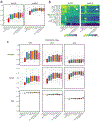Benchmarking Computational Doublet-Detection Methods for Single-Cell RNA Sequencing Data
- PMID: 33338399
- PMCID: PMC7897250
- DOI: 10.1016/j.cels.2020.11.008
Benchmarking Computational Doublet-Detection Methods for Single-Cell RNA Sequencing Data
Abstract
In single-cell RNA sequencing (scRNA-seq), doublets form when two cells are encapsulated into one reaction volume. The existence of doublets, which appear to be-but are not-real cells, is a key confounder in scRNA-seq data analysis. Computational methods have been developed to detect doublets in scRNA-seq data; however, the scRNA-seq field lacks a comprehensive benchmarking of these methods, making it difficult for researchers to choose an appropriate method for specific analyses. We conducted a systematic benchmark study of nine cutting-edge computational doublet-detection methods. Our study included 16 real datasets, which contained experimentally annotated doublets, and 112 realistic synthetic datasets. We compared doublet-detection methods regarding detection accuracy under various experimental settings, impacts on downstream analyses, and computational efficiencies. Our results show that existing methods exhibited diverse performance and distinct advantages in different aspects. Overall, the DoubletFinder method has the best detection accuracy, and the cxds method has the highest computational efficiency. A record of this paper's transparent peer review process is included in the Supplemental Information.
Keywords: cell clustering; differential gene expression; doublet detection; parallel computing; reproducibility; scRNA-seq; software implementation; trajectory inference.
Copyright © 2020 Elsevier Inc. All rights reserved.
Conflict of interest statement
Declaration of Interests The authors declare no competing interests.
Figures





References
-
- Allaire JJ et al. (2018) ‘reticulate: Interface to’Python’’, R package version, 1(8).
-
- Bernstein NJ et al. (2020) ‘Solo: Doublet Identification in Single-Cell RNA-Seq via Semi-Supervised Deep Learning’, Cell systems, 11(1), pp. 95–101.e5. - PubMed
Publication types
MeSH terms
Grants and funding
LinkOut - more resources
Full Text Sources
Other Literature Sources

